Healthcare Plan for Older Inmates: Challenges and Solutions Analysis
VerifiedAdded on 2022/09/28
|6
|1221
|38
Report
AI Summary
This report addresses the critical healthcare challenges faced by the rapidly growing population of older inmates in the USA. It begins by highlighting the increase in older prisoners due to long sentences and mandatory minimums, alongside the strain on healthcare resources. The report explores the issues of inadequate healthcare service providers and funding limitations within correctional facilities. It then proposes a healthcare plan for inmates, including educating younger inmates to provide care. The report outlines a time frame for implementing these strategies, including recruiting healthcare professionals, training younger inmates, and establishing a monitoring team. The report uses literature to provide evidence of the issues and offer potential solutions for improving healthcare for older inmates.
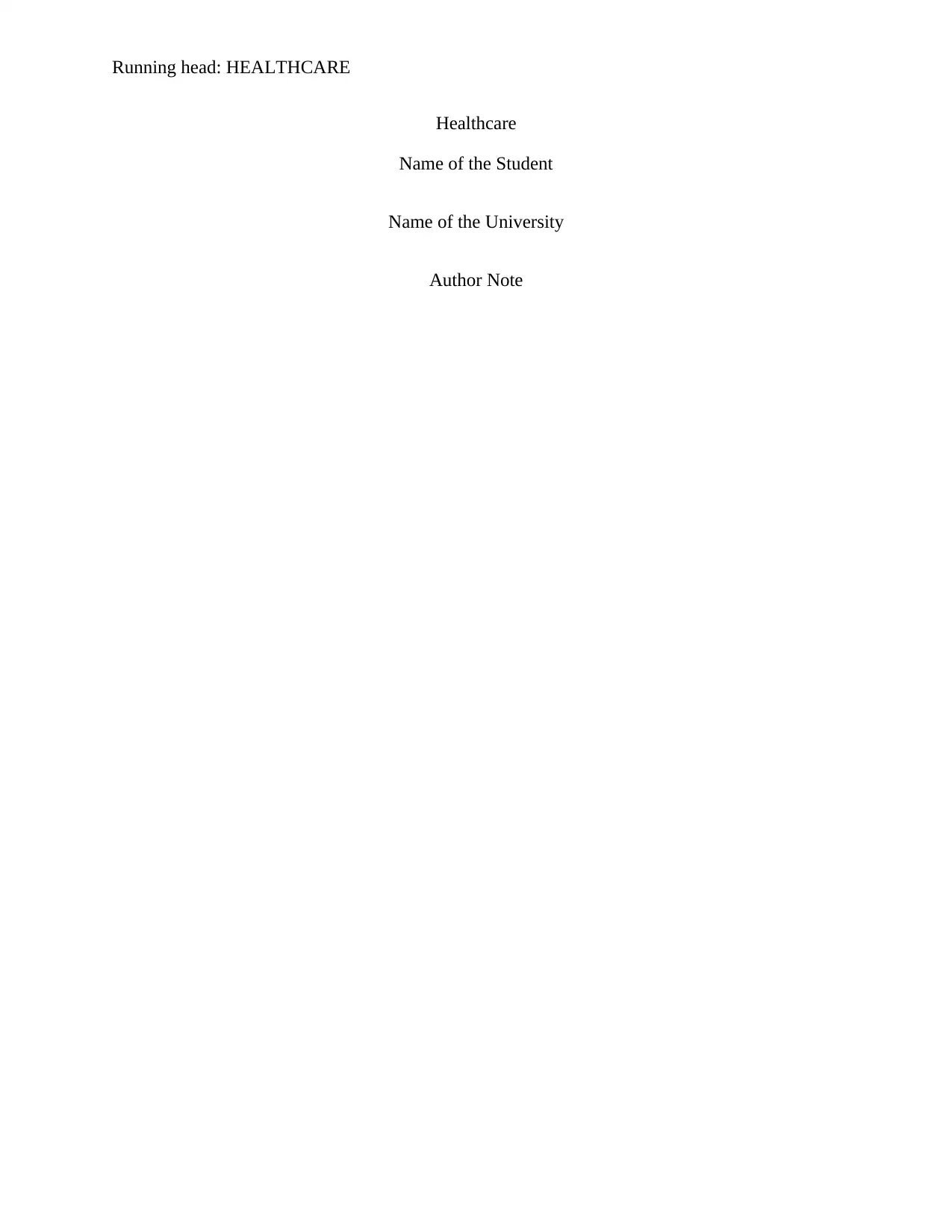
Running head: HEALTHCARE
Healthcare
Name of the Student
Name of the University
Author Note
Healthcare
Name of the Student
Name of the University
Author Note
Paraphrase This Document
Need a fresh take? Get an instant paraphrase of this document with our AI Paraphraser
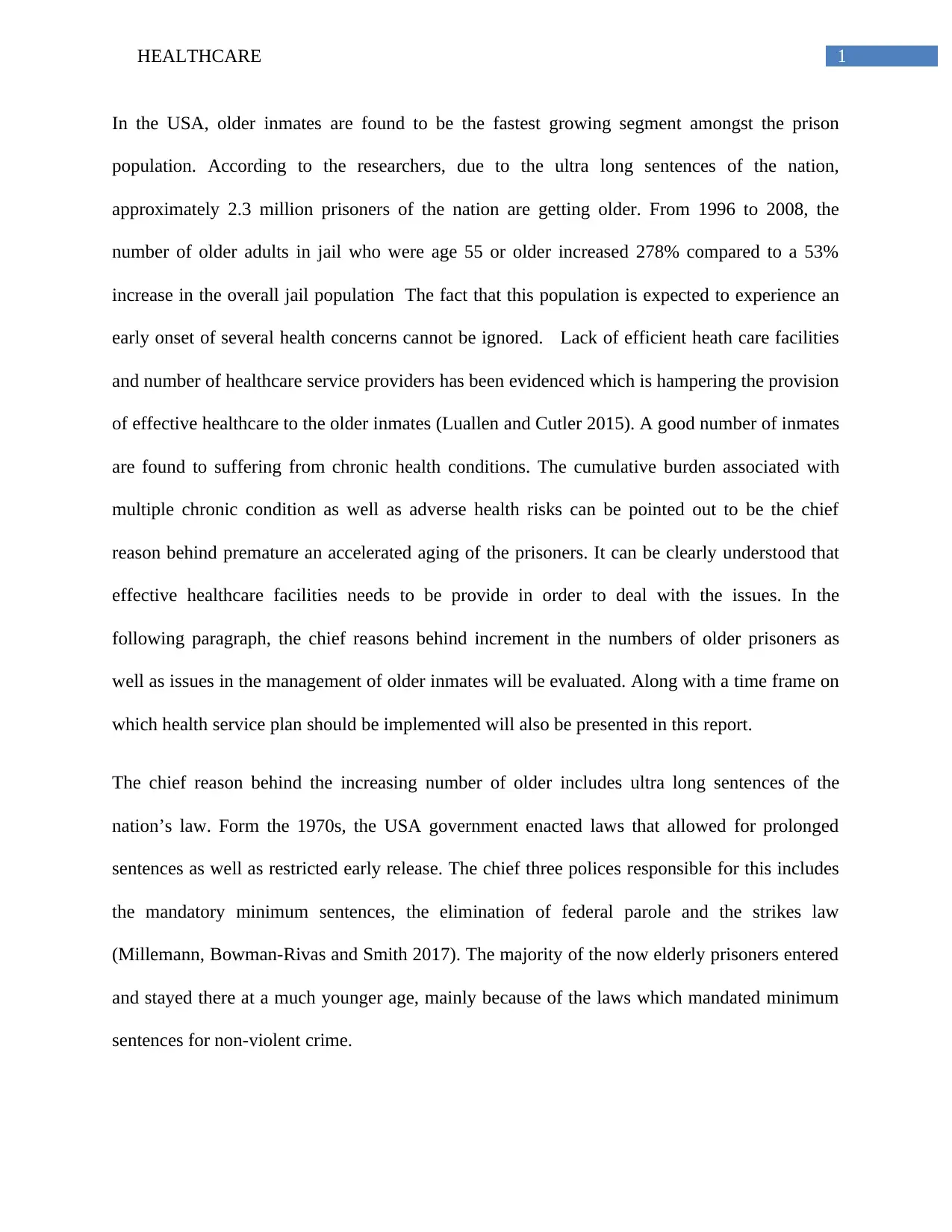
1HEALTHCARE
In the USA, older inmates are found to be the fastest growing segment amongst the prison
population. According to the researchers, due to the ultra long sentences of the nation,
approximately 2.3 million prisoners of the nation are getting older. From 1996 to 2008, the
number of older adults in jail who were age 55 or older increased 278% compared to a 53%
increase in the overall jail population The fact that this population is expected to experience an
early onset of several health concerns cannot be ignored. Lack of efficient heath care facilities
and number of healthcare service providers has been evidenced which is hampering the provision
of effective healthcare to the older inmates (Luallen and Cutler 2015). A good number of inmates
are found to suffering from chronic health conditions. The cumulative burden associated with
multiple chronic condition as well as adverse health risks can be pointed out to be the chief
reason behind premature an accelerated aging of the prisoners. It can be clearly understood that
effective healthcare facilities needs to be provide in order to deal with the issues. In the
following paragraph, the chief reasons behind increment in the numbers of older prisoners as
well as issues in the management of older inmates will be evaluated. Along with a time frame on
which health service plan should be implemented will also be presented in this report.
The chief reason behind the increasing number of older includes ultra long sentences of the
nation’s law. Form the 1970s, the USA government enacted laws that allowed for prolonged
sentences as well as restricted early release. The chief three polices responsible for this includes
the mandatory minimum sentences, the elimination of federal parole and the strikes law
(Millemann, Bowman-Rivas and Smith 2017). The majority of the now elderly prisoners entered
and stayed there at a much younger age, mainly because of the laws which mandated minimum
sentences for non-violent crime.
In the USA, older inmates are found to be the fastest growing segment amongst the prison
population. According to the researchers, due to the ultra long sentences of the nation,
approximately 2.3 million prisoners of the nation are getting older. From 1996 to 2008, the
number of older adults in jail who were age 55 or older increased 278% compared to a 53%
increase in the overall jail population The fact that this population is expected to experience an
early onset of several health concerns cannot be ignored. Lack of efficient heath care facilities
and number of healthcare service providers has been evidenced which is hampering the provision
of effective healthcare to the older inmates (Luallen and Cutler 2015). A good number of inmates
are found to suffering from chronic health conditions. The cumulative burden associated with
multiple chronic condition as well as adverse health risks can be pointed out to be the chief
reason behind premature an accelerated aging of the prisoners. It can be clearly understood that
effective healthcare facilities needs to be provide in order to deal with the issues. In the
following paragraph, the chief reasons behind increment in the numbers of older prisoners as
well as issues in the management of older inmates will be evaluated. Along with a time frame on
which health service plan should be implemented will also be presented in this report.
The chief reason behind the increasing number of older includes ultra long sentences of the
nation’s law. Form the 1970s, the USA government enacted laws that allowed for prolonged
sentences as well as restricted early release. The chief three polices responsible for this includes
the mandatory minimum sentences, the elimination of federal parole and the strikes law
(Millemann, Bowman-Rivas and Smith 2017). The majority of the now elderly prisoners entered
and stayed there at a much younger age, mainly because of the laws which mandated minimum
sentences for non-violent crime.
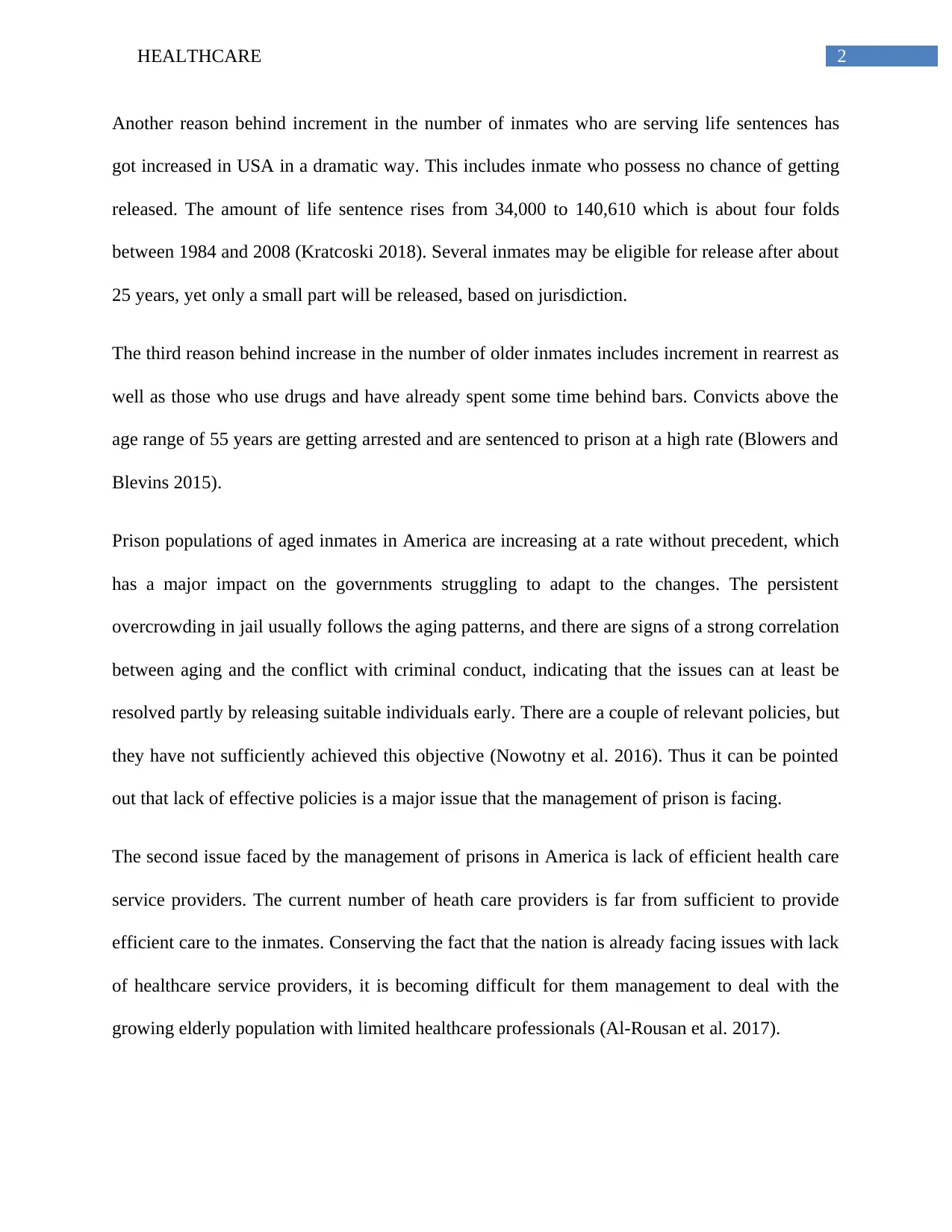
2HEALTHCARE
Another reason behind increment in the number of inmates who are serving life sentences has
got increased in USA in a dramatic way. This includes inmate who possess no chance of getting
released. The amount of life sentence rises from 34,000 to 140,610 which is about four folds
between 1984 and 2008 (Kratcoski 2018). Several inmates may be eligible for release after about
25 years, yet only a small part will be released, based on jurisdiction.
The third reason behind increase in the number of older inmates includes increment in rearrest as
well as those who use drugs and have already spent some time behind bars. Convicts above the
age range of 55 years are getting arrested and are sentenced to prison at a high rate (Blowers and
Blevins 2015).
Prison populations of aged inmates in America are increasing at a rate without precedent, which
has a major impact on the governments struggling to adapt to the changes. The persistent
overcrowding in jail usually follows the aging patterns, and there are signs of a strong correlation
between aging and the conflict with criminal conduct, indicating that the issues can at least be
resolved partly by releasing suitable individuals early. There are a couple of relevant policies, but
they have not sufficiently achieved this objective (Nowotny et al. 2016). Thus it can be pointed
out that lack of effective policies is a major issue that the management of prison is facing.
The second issue faced by the management of prisons in America is lack of efficient health care
service providers. The current number of heath care providers is far from sufficient to provide
efficient care to the inmates. Conserving the fact that the nation is already facing issues with lack
of healthcare service providers, it is becoming difficult for them management to deal with the
growing elderly population with limited healthcare professionals (Al-Rousan et al. 2017).
Another reason behind increment in the number of inmates who are serving life sentences has
got increased in USA in a dramatic way. This includes inmate who possess no chance of getting
released. The amount of life sentence rises from 34,000 to 140,610 which is about four folds
between 1984 and 2008 (Kratcoski 2018). Several inmates may be eligible for release after about
25 years, yet only a small part will be released, based on jurisdiction.
The third reason behind increase in the number of older inmates includes increment in rearrest as
well as those who use drugs and have already spent some time behind bars. Convicts above the
age range of 55 years are getting arrested and are sentenced to prison at a high rate (Blowers and
Blevins 2015).
Prison populations of aged inmates in America are increasing at a rate without precedent, which
has a major impact on the governments struggling to adapt to the changes. The persistent
overcrowding in jail usually follows the aging patterns, and there are signs of a strong correlation
between aging and the conflict with criminal conduct, indicating that the issues can at least be
resolved partly by releasing suitable individuals early. There are a couple of relevant policies, but
they have not sufficiently achieved this objective (Nowotny et al. 2016). Thus it can be pointed
out that lack of effective policies is a major issue that the management of prison is facing.
The second issue faced by the management of prisons in America is lack of efficient health care
service providers. The current number of heath care providers is far from sufficient to provide
efficient care to the inmates. Conserving the fact that the nation is already facing issues with lack
of healthcare service providers, it is becoming difficult for them management to deal with the
growing elderly population with limited healthcare professionals (Al-Rousan et al. 2017).
⊘ This is a preview!⊘
Do you want full access?
Subscribe today to unlock all pages.

Trusted by 1+ million students worldwide
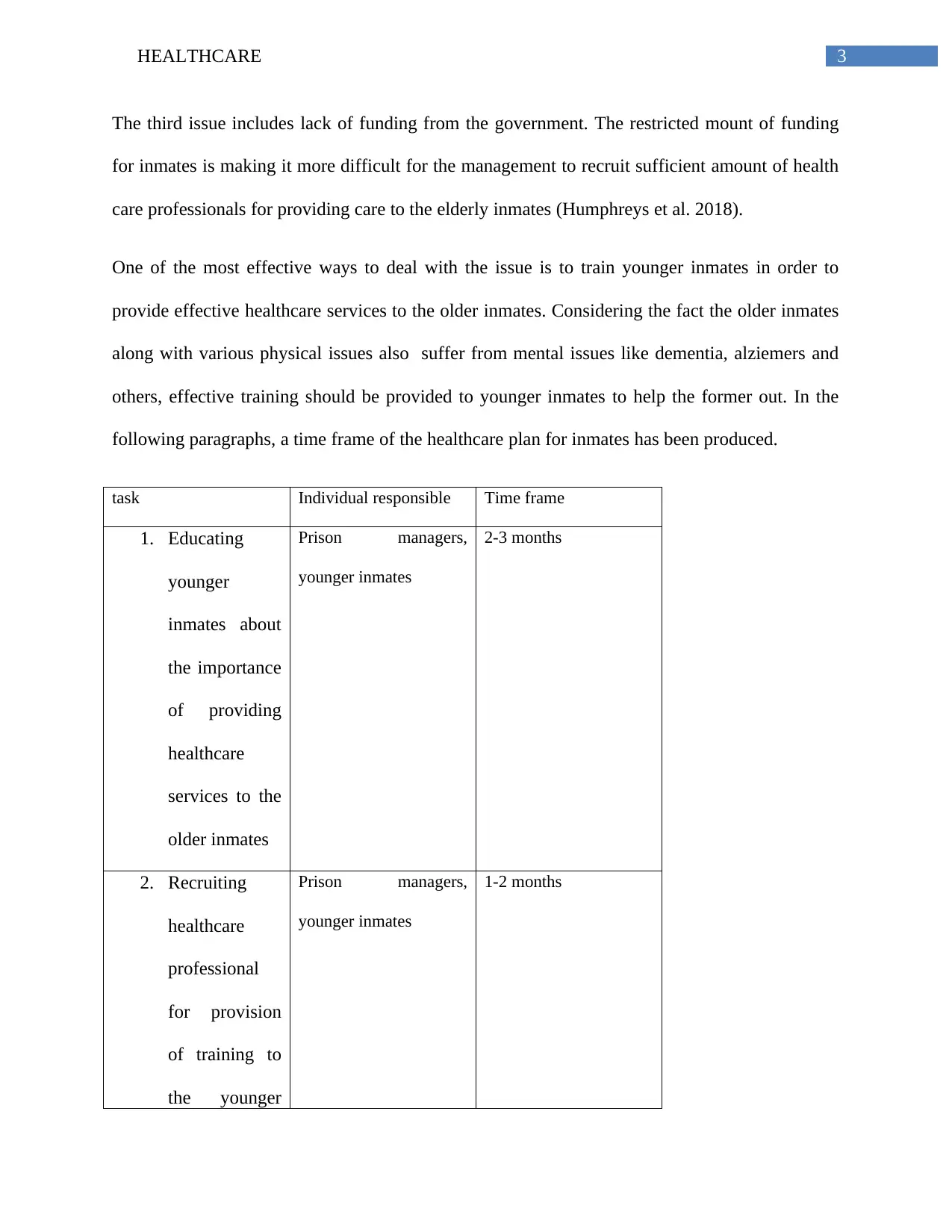
3HEALTHCARE
The third issue includes lack of funding from the government. The restricted mount of funding
for inmates is making it more difficult for the management to recruit sufficient amount of health
care professionals for providing care to the elderly inmates (Humphreys et al. 2018).
One of the most effective ways to deal with the issue is to train younger inmates in order to
provide effective healthcare services to the older inmates. Considering the fact the older inmates
along with various physical issues also suffer from mental issues like dementia, alziemers and
others, effective training should be provided to younger inmates to help the former out. In the
following paragraphs, a time frame of the healthcare plan for inmates has been produced.
task Individual responsible Time frame
1. Educating
younger
inmates about
the importance
of providing
healthcare
services to the
older inmates
Prison managers,
younger inmates
2-3 months
2. Recruiting
healthcare
professional
for provision
of training to
the younger
Prison managers,
younger inmates
1-2 months
The third issue includes lack of funding from the government. The restricted mount of funding
for inmates is making it more difficult for the management to recruit sufficient amount of health
care professionals for providing care to the elderly inmates (Humphreys et al. 2018).
One of the most effective ways to deal with the issue is to train younger inmates in order to
provide effective healthcare services to the older inmates. Considering the fact the older inmates
along with various physical issues also suffer from mental issues like dementia, alziemers and
others, effective training should be provided to younger inmates to help the former out. In the
following paragraphs, a time frame of the healthcare plan for inmates has been produced.
task Individual responsible Time frame
1. Educating
younger
inmates about
the importance
of providing
healthcare
services to the
older inmates
Prison managers,
younger inmates
2-3 months
2. Recruiting
healthcare
professional
for provision
of training to
the younger
Prison managers,
younger inmates
1-2 months
Paraphrase This Document
Need a fresh take? Get an instant paraphrase of this document with our AI Paraphraser
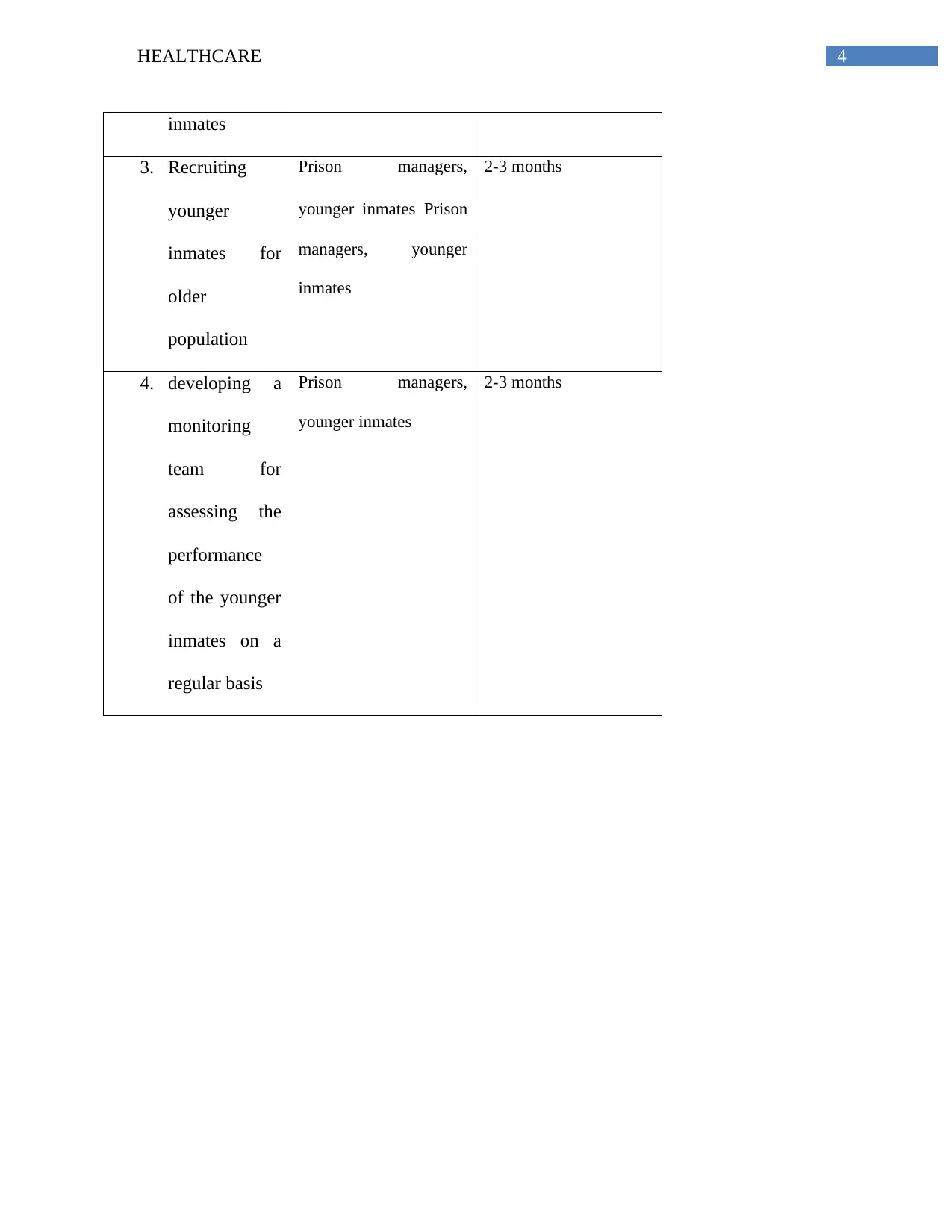
4HEALTHCARE
inmates
3. Recruiting
younger
inmates for
older
population
Prison managers,
younger inmates Prison
managers, younger
inmates
2-3 months
4. developing a
monitoring
team for
assessing the
performance
of the younger
inmates on a
regular basis
Prison managers,
younger inmates
2-3 months
inmates
3. Recruiting
younger
inmates for
older
population
Prison managers,
younger inmates Prison
managers, younger
inmates
2-3 months
4. developing a
monitoring
team for
assessing the
performance
of the younger
inmates on a
regular basis
Prison managers,
younger inmates
2-3 months
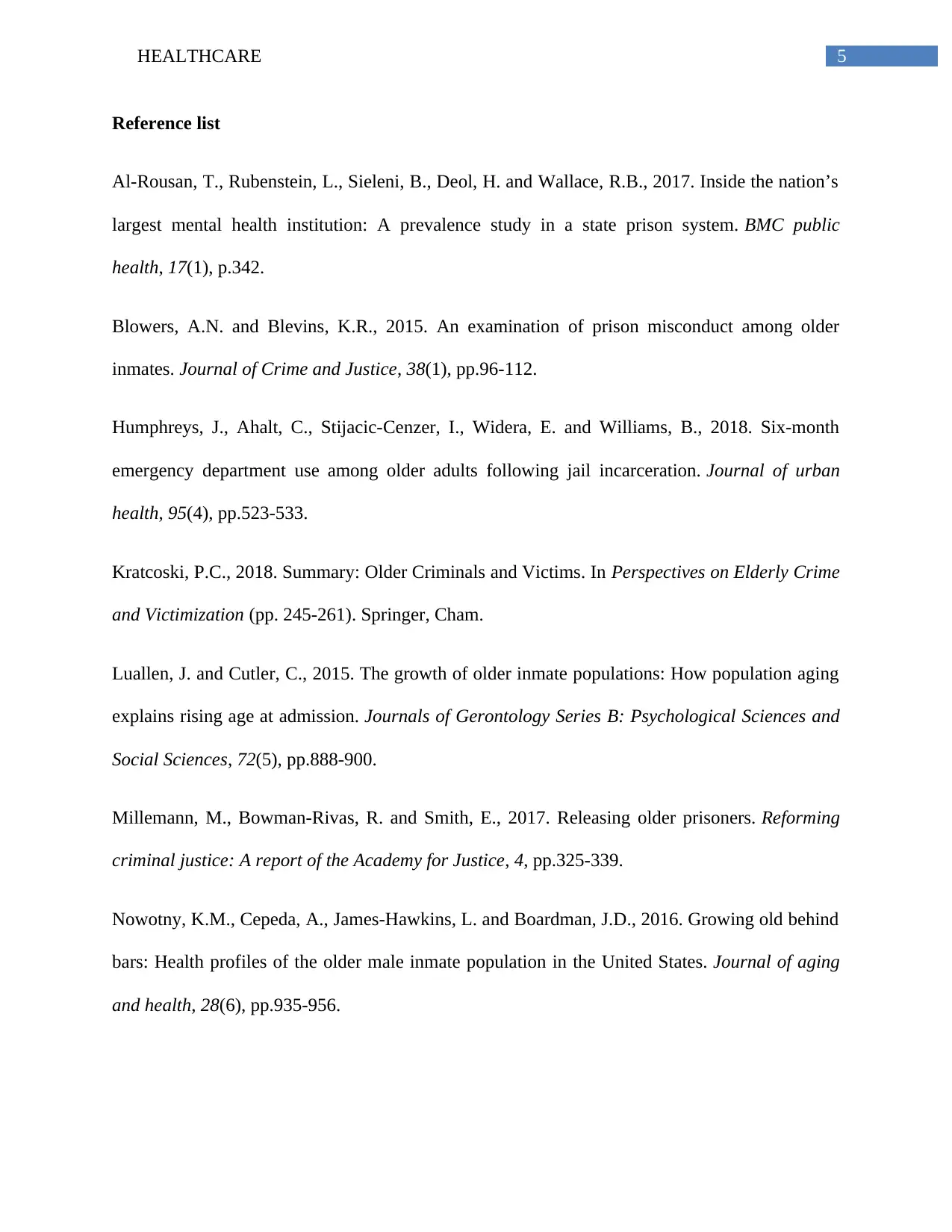
5HEALTHCARE
Reference list
Al-Rousan, T., Rubenstein, L., Sieleni, B., Deol, H. and Wallace, R.B., 2017. Inside the nation’s
largest mental health institution: A prevalence study in a state prison system. BMC public
health, 17(1), p.342.
Blowers, A.N. and Blevins, K.R., 2015. An examination of prison misconduct among older
inmates. Journal of Crime and Justice, 38(1), pp.96-112.
Humphreys, J., Ahalt, C., Stijacic-Cenzer, I., Widera, E. and Williams, B., 2018. Six-month
emergency department use among older adults following jail incarceration. Journal of urban
health, 95(4), pp.523-533.
Kratcoski, P.C., 2018. Summary: Older Criminals and Victims. In Perspectives on Elderly Crime
and Victimization (pp. 245-261). Springer, Cham.
Luallen, J. and Cutler, C., 2015. The growth of older inmate populations: How population aging
explains rising age at admission. Journals of Gerontology Series B: Psychological Sciences and
Social Sciences, 72(5), pp.888-900.
Millemann, M., Bowman-Rivas, R. and Smith, E., 2017. Releasing older prisoners. Reforming
criminal justice: A report of the Academy for Justice, 4, pp.325-339.
Nowotny, K.M., Cepeda, A., James-Hawkins, L. and Boardman, J.D., 2016. Growing old behind
bars: Health profiles of the older male inmate population in the United States. Journal of aging
and health, 28(6), pp.935-956.
Reference list
Al-Rousan, T., Rubenstein, L., Sieleni, B., Deol, H. and Wallace, R.B., 2017. Inside the nation’s
largest mental health institution: A prevalence study in a state prison system. BMC public
health, 17(1), p.342.
Blowers, A.N. and Blevins, K.R., 2015. An examination of prison misconduct among older
inmates. Journal of Crime and Justice, 38(1), pp.96-112.
Humphreys, J., Ahalt, C., Stijacic-Cenzer, I., Widera, E. and Williams, B., 2018. Six-month
emergency department use among older adults following jail incarceration. Journal of urban
health, 95(4), pp.523-533.
Kratcoski, P.C., 2018. Summary: Older Criminals and Victims. In Perspectives on Elderly Crime
and Victimization (pp. 245-261). Springer, Cham.
Luallen, J. and Cutler, C., 2015. The growth of older inmate populations: How population aging
explains rising age at admission. Journals of Gerontology Series B: Psychological Sciences and
Social Sciences, 72(5), pp.888-900.
Millemann, M., Bowman-Rivas, R. and Smith, E., 2017. Releasing older prisoners. Reforming
criminal justice: A report of the Academy for Justice, 4, pp.325-339.
Nowotny, K.M., Cepeda, A., James-Hawkins, L. and Boardman, J.D., 2016. Growing old behind
bars: Health profiles of the older male inmate population in the United States. Journal of aging
and health, 28(6), pp.935-956.
⊘ This is a preview!⊘
Do you want full access?
Subscribe today to unlock all pages.

Trusted by 1+ million students worldwide
1 out of 6
Related Documents
Your All-in-One AI-Powered Toolkit for Academic Success.
+13062052269
info@desklib.com
Available 24*7 on WhatsApp / Email
![[object Object]](/_next/static/media/star-bottom.7253800d.svg)
Unlock your academic potential
Copyright © 2020–2025 A2Z Services. All Rights Reserved. Developed and managed by ZUCOL.



